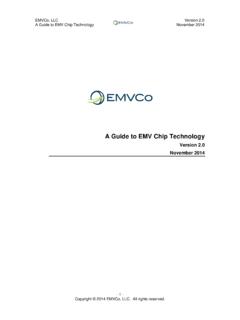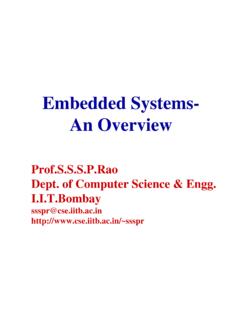Transcription of MicroBlaze Tutorial Creating a Simple Embedded System …
1 Embedded Computing and Signal Processing Laboratory Illinois Institute of Technology 1 MicroBlaze Tutorial Creating a Simple Embedded System and Adding Custom Peripherals Using Xilinx EDK Software Tools Rod Jesman Fernando Martinez Vallina Jafar Saniie Embedded Computing and Signal Processing Laboratory Illinois Institute of Technology 2 INTRODUCTION This Tutorial guides you through the process of using Xilinx Embedded Development Kit (EDK) software tools, in which this Tutorial will use the Xilinx Platform Studio (XPS) tool to create a Simple processor System and the process of adding a custom OPB peripheral (an 32-bit adder circuit) to that processor System by using the Import Peripheral Wizard.
2 OBJECTIVES After completing this Tutorial , you will be able to: Create an XPS Project by using Base System Builder (BSB) Create a Simple hardware design by using Xilinx IPs available in the Embedded Design Kit Add a custom IP to your design Modify a Xilinx generated software application to access an IP peripheral Implement the design Generate and Download the bit file to verify in hardware In order to download the completed processor System , you must have the following hardware: Xilinx Spartan-3 Evaluation Board (3S200 FT256 4) Xilinx Parallel -4 Cable used to program and debug the device Serial Cable PROCEDURE The purpose of the Tutorial is to walk you through a complete hardware and software processor System design.
3 In this Tutorial , you will use the BSB of the XPS System to automatically create a processor System and then add a custom OPB peripheral (adder circuit) to that processor System which will consist of the following items: MicroBlaze Processor Local Memory Bus (LMB) Bus LMB BRAM controllers for BRAM BRAM BLOCK (On-chip memory) On-chip Peripheral Bus (OPB) BUS Debug Module (OPB_MDM) UART (OPB_UARTLITE) 2 - General Purpose Input/Output pheriphals (OPB_GPIOs) Push Buttons Dip Switches Custom peripheral (32-bit adder circuit)
4 Embedded Computing and Signal Processing Laboratory Illinois Institute of Technology 3 BACKGROUND First, before designing the Embedded processor System , some background information needs to be provided to inform you about the processor to be used and some items about the Xilinx Embedded Development Kit (EDK) software tools. The microprocessors available for use in Xilinx Field Programmable Gate Arrays (FPGAs) with Xilinx EDK software tools can be broken down into two broad categories. There are soft-core microprocessors ( MicroBlaze ) and the hard-core Embedded microprocessor (PowerPC).
5 This Tutorial will only focus on the soft-core MicroBlaze microprocessor , which can be used in most of the Spartan-II, Spartan-3 and Virtex FPGA families. The hard-core Embedded microprocessor mentioned is an IBM PowerPC 405 processor, which is only available in the Virtex-II Pro and Virtex-4 FX FPGA s. You don't have to use the PowerPC 405 processors but you also can't remove them from the Virtex-II Pro and Virtex-4 FX FPGA s because they are in the fabric of the chip. This section will now go into more details about the MicroBlaze microprocessor and Xilinx Embedded Development Kit (EDK) software tools.
6 The MicroBlaze is a virtual microprocessor that is built by combining blocks of code called cores inside a Xilinx Field Programmable Gate Array (FPGA). The beauty to this approach is that you only end up with as much microprocessor as you need. You can also tailor the project to your specific needs ( : Flash, UART, General Purpose Input/Output pheriphals and etc.). The MicroBlaze processor is a 32-bit Harvard Reduced Instruction Set Computer (RISC) architecture optimized for implementation in Xilinx FPGAs with separate 32-bit instruction and data buses running at full speed to execute programs and access data from both on-chip and external memory at the same time.
7 The backbone of the architecture is a single-issue, 3-stage pipeline with 32 general-purpose registers (does not have any address registers like the Motorola 68000 Processor), an Arithmetic Logic Unit (ALU), a shift unit, and two levels of interrupt. This basic design can then be configured with more advanced features to tailor to the exact needs of the target Embedded application such as: barrel shifter, divider, multiplier, single precision floating-point unit (FPU), instruction and data caches, exception handling, debug logic, Fast Simplex Link (FSL) interfaces and others.
8 This flexibility allows the user to balance the required performance of the target application against the logic area cost of the soft processor. Figure 1 shows a view of a MicroBlaze System . The items in white are the backbone of the MicroBlaze architecture while the items shaded gray are optional features available depending on the exact needs of the target Embedded application. Because MicroBlaze is a soft-core microprocessor , any optional features not used will not be implemented and will not take up any of the FPGAs resources.
9 The MicroBlaze pipeline is a parallel pipeline, divided into three stages: Fetch, Decode, and Execute. In general, each stage takes one clock cycle to complete. Consequently, it takes three clock cycles (ignoring delays or stalls) for the instruction to complete. Each stage is active on each clock cycle so three instructions can be executed simultaneously, one at each of the three pipeline stages. MicroBlaze implements an Instruction Prefetch Buffer that reduces the impact of multi-cycle instruction memory latency. While the pipeline is stalled by a multi-cycle instruction in the execution stage the Instruction Prefetch Buffer continues to load sequential instructions.
10 Once the pipeline resumes execution the fetch stage can load new instructions directly from the Instruction Prefetch Buffer rather than having to wait for the instruction memory access to complete. The Instruction Prefetch Buffer is part of the backbone of the MicroBlaze architecture and is not the same thing as the optional instruction cache. Embedded Computing and Signal Processing Laboratory Illinois Institute of Technology 4 Figure 1-1. A view of a MicroBlaze System The MicroBlaze core is organized as a Harvard architecture with separate bus interface units for data accesses and instruction accesses.







